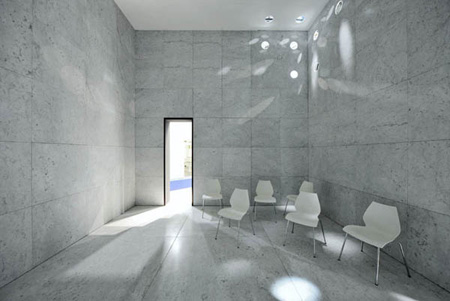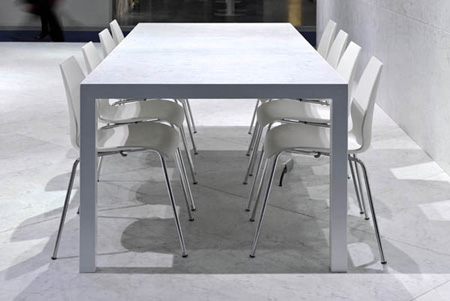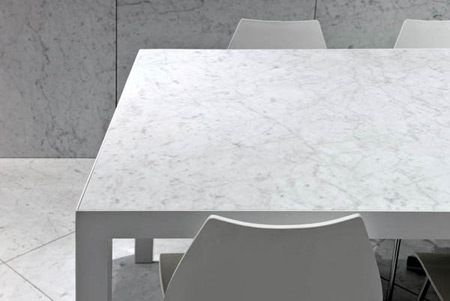30 Novembre 2009
English
ALBERTO CAMPO BAEZA AND THE CARRARA MARBLE
Pibamarmi and Telara at 2009 Marmomacc

The Apuan Bianco Lavagnina marble covers the interior surfaces of Pibamarmi’s pavilion, designed by Alberto Campo Baeza for 2009 Marmomacc (ph Giovanni De Sandre)
“If there’s places in Italy worth to gain attention from naturalists, one of these is undoubtedly the territory of the Apuan Alps, small mountain chain in the farthest extremity of Etruria. This place […] is very peculiar in the physical history of our Globe for the structure and the formation of its stones, having Nature deposited here, since the primitive age, the whitest and finest marble to be employed in arts. […] In the western part of this chain the deepest precipices can be found, among which Pizzo d’Uccello is one of the most remarkable, being a very high cliff with the form of a peak that vertically subsides to the foot of the mountains in the Lucido valley. To have a clear idea of the corrosive action of the waters that fall from this cliff it’s sufficient to look the deep and narrow bed dig by the river of the same name, the banks of which are surrounded by white marbles smoothed by the friction of the water flow.”
With these words, Emaunele Repetti starts its well-known volume “Sopra l’Alpe Apuana ed i marmi di Carrara (“On Apuan Alps and Carrara marbles”, 1820), introducing the reader with clearness and efficacy to the particular aspects of the landscape and to the specific geology of this little geographical region caught between the Apennine dorsal and the Tirrenian sea. The rough and magnificent orography of the Apuan Alps, and the beauty of the marbles which are originated in these mountains, have always impressed travellers, artists and literates: Rutilio Namaziano wrote in the V cent. A.D., “dives marmoribus tellus, quae luce coloris provocat intactas luxoriosa nives” referring to the paleness of the marble extractions that remind of perennial snows; Dante recalled the impression provoked by the peaks of the Panie (ancient name of the Alpuan Alps) and of its stones; and Repetti, in another point of its work, reported that “according to Vasari, Michelangelo, who in 1515 frequented those quarries, had the extraordinary idea of reduce that crest into a colossal statue, idea that was recalled some years ago, in order to hit the attention of the sailors from the greatest distances”.
The image of the Carrara marbles’ whiteness, very frequently fixed in the tradition, hides in reality an extraordinary richness in chromatic and textural varieties, that distinguish this kind of materials with a homogenous, delicate and compact saccaroid structure. Indeed Apuan marbles, extracted in the docks of Torano, Fantiscritti or Colonnata, can be white with more or less intense nuances coloured in cream or grey-blue, or even in some cases with darker grey colours; textures can be subtly veined, or more boldly arabesque-like or opaque.


Tabla Bianca table, designed by Antonio Campo Baeza for Pibamarmi and manufactured in Bianco Lavagnina marble (ph Giovanni De Sandre)
In parallel to such a variety of aspects there’s a high multiplicity of denominations: Bianchi, Bianchi Chiari, Bianchi Venati, Statuari, Cipollini, Crema Delicati, Arabescati, Calcatta, Bardigli; and the specifications of the place of excavation can be often added as in the case of Bianco Lavagnina, that can be found in the homonymous quarry of the Colonnata dock on the slopes of Mount Gioia. This material, characterized by a very light grey homogenous tone, presents subtle darker streaks; the excavation site is carried on generation after generation by Carlo Telara, a firm based in Carrara consolidated by a family tradition exporting materials all over the world and keeping the Apuan marble in contact with the creative contributions of contemporary architects and artists.
The meeting of the Bianco Lavagnina and one of the principal protagonists of contemporary architectural culture happened during the last edition of the Marmomacc fair in Verona: in this occasion, in fact, Alberto Campo Baeza, Spanish architect of established international fame, employed this material to give life to the refined project of “La Idea Construida”, exhibition pavilion for the stone brand PIBAMARMI.
The interior of the structure, centred on the theme of the relationship between stone, light and time, has been offered to the visitors as a void space for resting and meditation, immersed in the penumbra and animated by the slow passage of luminous rays over the natural surfaces in Apuan marble, that was cut in big squared modules employed to continuously cover the walls and the floor of this essential stone chamber.
The architect has then declined the Bianco Lavagnina in the design of a big table with a monolithical surface and a metallic structure, where the interpretation of the characteristic of the marble are brought to particularly refined solutions. Campo Baeza himself clearly explains the reason of his choice: “Carrara marble is marvellous and sublime, it was certainly the most appropriate material to create this stone chamber crossed by a reproduction of the solar light in movement; a Greek white marble would have been too homogenous, too artificially perfect, it wouldn’t have been so vibrating and it wouldn’t have allowed to be caressed by the passage of luminous flows; this Carrara marble, with its very subtle veins, with its soft and warm grey nuances, with its natural grain, is universal and eternal”.
by Davide Turrini
See also:
Intervista ad Alberto Campo Baeza
Bianco Lavagnina
Pibamarmi
Carlo Telara
